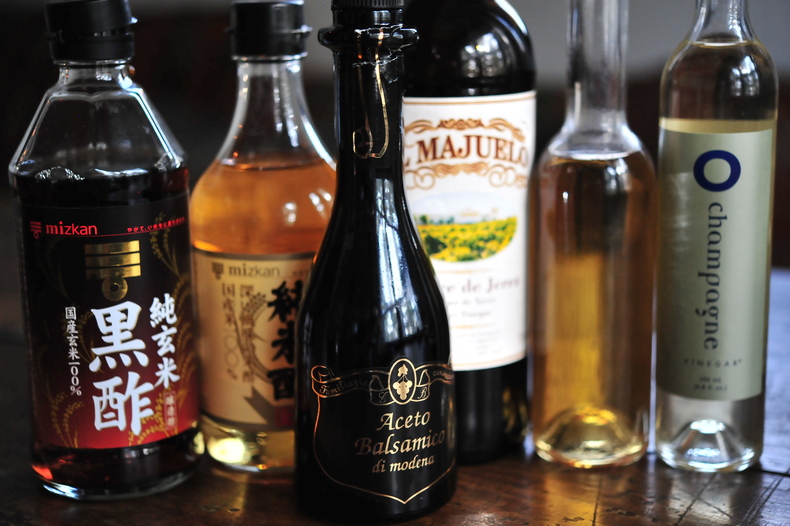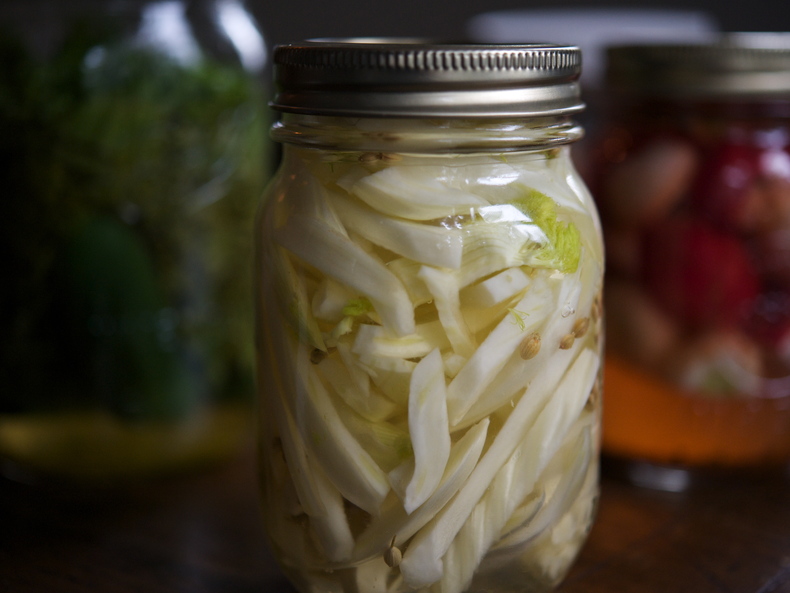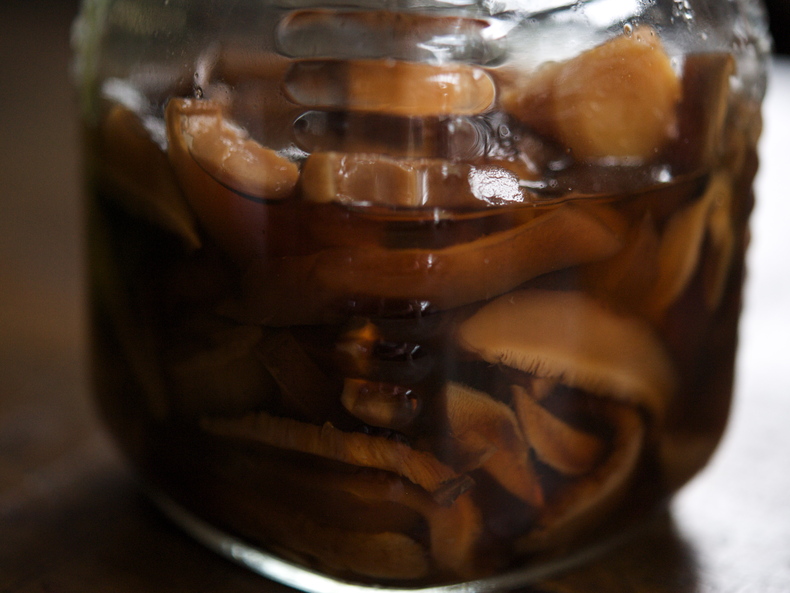3.16.10 Pucker Up

from left: brown rice, white rice, balsamic, sherry, cider and champagne vinegars
I've had some positive feedback on my round-ups of ingredients, so here's a new one for you. This time it's vinegar, in some of its many permutations. As children, my sisters and I called each other "Vinegar Pig." This originated from our love of drinking glugs of white vinegar straight from the bottle while dyeing Easter eggs. I've never been one to shy away from sour pickles or throat-scratchingly tart salad dressings, and I'm still known to take a swig from the bottle of balsamic, but I think by now I've learned how to employ vinegar to slightly more subtle effect.

Since ancient times, people from all over the world have let wild acetic-acid bacteria turn their alcoholic beverages to vinegar. The word comes for the French for sour wine, vin aigre. Naturally-brewed vinegars are derived from sugar cane, molasses, fruit or grain, and each has its distinctive flavor, aroma and color. Vinegars are vital as food preservatives (pickles), and they play important roles in health and beauty aids, antiseptics, cleaning solutions and medicines. Paradoxically, although it’s sour, vinegar helps your system stay more alkaline than acidic, a preferable, more balanced state. All foods we eat, after being digested and metabolized, release either an acid or alkaline base into the blood. The foods that we tend to overeat—grains, meat, dairy products—are all acid-producing and can lead to a lack of energy, excessive mucous production, infections, anxiety, irritability, headache, sore throat, nasal and sinus congestion, allergic reactions and even arthritis.
Medical researchers believe it is the amino acids and enzymes present in vinegar, a product of fermentation, that are partly responsible for its tonic properties. Some studies suggest that vinegars may help to lower glucose levels, and that they can lower the post-meal rise in glucose. The acetic acid in vinegar is thought to slow starch digestion and reduce the glycemic index of starchy foods. For example, researchers found that those who consumed vinegar along with white bread had lower post-meal blood glucose and insulin levels and also felt more satisfied after eating.The taste of vinegar is a wonderful counterpoint to sweet and salty flavors, and it cuts through fat easily. Have you ever noticed how pickles are often served alongside fatty foods of every nationality? Sour dills with pastrami; bread-&-butter cukes with pulled pork; pickled ginger with sushi; pickled daikon with tempura; sauerkraut with sausages; kimchi with Korean barbecue…it goes on and on. This is because they help break down the fats and ease digestion. Supposedly, if you add a couple of teaspoons of vinegar to a pot of beans, once the beans are tender, you won’t be playing so much butt trumpet. I often enjoy an apple cider vinegar and honey “tea” in the morning (see below). It tastes delicious and can really soothe a sour stomach. I like vinegar-based dipping sauces and salad dressings, and frequently add some type of vinegar to cut through any creamy sauce or gravy that needs a little brightening. I even love a drizzle of balsamic vinegar over ice cream or panna cotta. For other ways to use vinegar, please read under each individual type, below.
APPLE CIDER VINEGAR During the process of fermenting apple cider, the sugar is broken down by bacteria and yeast, first into alcohol and then into vinegar. Apple cider vinegar is often sold unfiltered and unpasteurized, with a dark, cloudy sediment called “mother of vinegar” settled at the bottom of the bottle. This slimy blob of acetic acid bacteria is a good thing and can simply be fished out and discarded, or even used to start other vinegars. A popular health tonic of the 19th century was two teaspoons of apple cider vinegar and a teaspoon of honey dissolved in a cup of hot water, used to treat everything from chronic fatigue and headache to high blood pressure and obesity. A 1:1 solution of apple cider vinegar to water is an excellent home remedy for dandruff. It helps restore the pH balance of the scalp and discourages the overgrowth of malassezia furfur (sounds like a Italian punk band!), the yeast-like fungus thought to trigger dandruff. Pour the vinegar mixture into a spray bottle and spritz on the hair and scalp once or twice a week, avoiding the eye and ear area. Wrap your head in a towel for 15 minutes to an hour, and then rinse out. A weak solution of apple cider vinegar and water can also be applied to breakouts.
RICE VINEGAR According to Dr. Yoshio Takino of Shizuka University, Japan, the twenty amino acids and sixteen organic acids found in rice vinegar help prevent the formation of toxic fat peroxides. These can form when unsaturated fatty acids from vegetable oils and other foods are heated and exposed to light in cooking or oxidized during metabolism, and they contribute to aging and to cholesterol formation on blood vessel walls.White rice vinegar (also called rice wine vinegar) is colorless to pale yellow, less acidic and milder in flavor that what we know as distilled white vinegar. (Distillation, by the way, removes much of the potassium and other nutritional value so this vinegar, like other heavily processed foods, should be avoided.) Japanese rice vinegar is very mild and mellow, and is also seen in a seasoned version with added sake, salt and sugar which you probably don’t really need to bother with. Brown rice vinegar has been called the eastern version of apple cider vinegar. It has a deeper color than white rice vinegar and a slightly richer, more umami flavor with a subtle sweetness.
BALSAMIC VINEGAR Italy’s aceto balsamico is a traditional product, made in Modena and Reggio Emilia since the Middle Ages. A reduction of cooked grape juice (mosto cotto) that is not really a vinegar in the truest sense, it is aged for a minimum of 12 years in a battery of seven barrels of successively smaller sizes. The casks are made of different woods such as chestnut, acacia, cherry, oak, etc. True balsamic vinegar is a glossy, deep brown color and has a rich, complex flavor balanced between sweet and sour. What we known as balsamic vinegar is sort of a lowlier imitation of the much-prized aged version, but still pretty good stuff.You can reduce balsamic vinegar in a saucepan over medium-high heat to create a sweeter, more syrupy version, perhaps even adding a little honey if you plan to drizzle this on panna cotta. Try macerating strawberries in a few tablespoons of balsamic, with a few grinds of fresh black pepper. The flavors are a revelation. I also stir a tablespoon or so into my tomato sauce for pasta.
WINE VINEGAR Vinegars made from wine differ according to the source of wine. Red wine vinegar adds a robust flavor and goes well with pungent greens (escarole, dandelion, radicchio), as well as meats and cheese—much like red wine itself. White wine vinegar has a lighter flavor and is excellent with tender, young greens (frisée, mâche) and pasta dishes.
SHERRY VINEGAR Sherry vinegar is produced in a very specific area of the Spanish province of Cádiz, and by law must undergo aging in oak for a minimum of six months. In this way, it approximates the regulation (and fetishization) of balsamico. Again, the style of this vinegar depends mainly on the grape variety used to produce the wine from which it is made. I like “al Pedro Ximénez,” which seems to be most widely available here, for its sweet, raisin-y taste. It may seem a bit obvious, but try sherry vinegar with Spanish-style dishes: in a salad of greens with Manchego cheese and Marcona almonds; splashed onto clams with chorizo; to brighten a sautee of spinach with raisins and pine nuts.
CHAMPAGNE VINEGAR This light vinegar has a taste similar to that of good quality champagne, and is wonderful in vinaigrettes and marinades for cold vegetables. Champagne vinegar is produced using Chardonnay or Pinot Noir grapes, and often has a hint of vanilla. Try mixing it with some chopped shallots as a mignonette with oysters, or with almond oil and lemon zest as a dressing for butter lettuce.I don’t like to seem immodest, but one thing I excel at is whipping up salad dressing. Once you make enough of them, you won’t bother with measurements, especially when you get the hang of how to mix them. You can customize them according to your meal, the greens you’re using, your mood. Lime juice and cumin are great with Mexican or Indian food. A little mayo and lemon goes well with seafood. Improvise! Start with your flavorings: mustard, sweetener (a little sugar, honey or agave is often essential to balance out the tart elements), garlic or shallots, herbs, etc; stir those together, then whisk in the acid: vinegar or lemon juice, or a combination. Once that’s blended, slowly drizzle in the oil while you keep whisking so it will emulsify. Then season to taste with salt and freshly ground pepper. You can also shake it all up vigorously in jar.
Medical researchers believe it is the amino acids and enzymes present in vinegar, a product of fermentation, that are partly responsible for its tonic properties. Some studies suggest that vinegars may help to lower glucose levels, and that they can lower the post-meal rise in glucose. The acetic acid in vinegar is thought to slow starch digestion and reduce the glycemic index of starchy foods. For example, researchers found that those who consumed vinegar along with white bread had lower post-meal blood glucose and insulin levels and also felt more satisfied after eating.The taste of vinegar is a wonderful counterpoint to sweet and salty flavors, and it cuts through fat easily. Have you ever noticed how pickles are often served alongside fatty foods of every nationality? Sour dills with pastrami; bread-&-butter cukes with pulled pork; pickled ginger with sushi; pickled daikon with tempura; sauerkraut with sausages; kimchi with Korean barbecue…it goes on and on. This is because they help break down the fats and ease digestion. Supposedly, if you add a couple of teaspoons of vinegar to a pot of beans, once the beans are tender, you won’t be playing so much butt trumpet. I often enjoy an apple cider vinegar and honey “tea” in the morning (see below). It tastes delicious and can really soothe a sour stomach. I like vinegar-based dipping sauces and salad dressings, and frequently add some type of vinegar to cut through any creamy sauce or gravy that needs a little brightening. I even love a drizzle of balsamic vinegar over ice cream or panna cotta. For other ways to use vinegar, please read under each individual type, below.
APPLE CIDER VINEGAR During the process of fermenting apple cider, the sugar is broken down by bacteria and yeast, first into alcohol and then into vinegar. Apple cider vinegar is often sold unfiltered and unpasteurized, with a dark, cloudy sediment called “mother of vinegar” settled at the bottom of the bottle. This slimy blob of acetic acid bacteria is a good thing and can simply be fished out and discarded, or even used to start other vinegars. A popular health tonic of the 19th century was two teaspoons of apple cider vinegar and a teaspoon of honey dissolved in a cup of hot water, used to treat everything from chronic fatigue and headache to high blood pressure and obesity. A 1:1 solution of apple cider vinegar to water is an excellent home remedy for dandruff. It helps restore the pH balance of the scalp and discourages the overgrowth of malassezia furfur (sounds like a Italian punk band!), the yeast-like fungus thought to trigger dandruff. Pour the vinegar mixture into a spray bottle and spritz on the hair and scalp once or twice a week, avoiding the eye and ear area. Wrap your head in a towel for 15 minutes to an hour, and then rinse out. A weak solution of apple cider vinegar and water can also be applied to breakouts.
RICE VINEGAR According to Dr. Yoshio Takino of Shizuka University, Japan, the twenty amino acids and sixteen organic acids found in rice vinegar help prevent the formation of toxic fat peroxides. These can form when unsaturated fatty acids from vegetable oils and other foods are heated and exposed to light in cooking or oxidized during metabolism, and they contribute to aging and to cholesterol formation on blood vessel walls.White rice vinegar (also called rice wine vinegar) is colorless to pale yellow, less acidic and milder in flavor that what we know as distilled white vinegar. (Distillation, by the way, removes much of the potassium and other nutritional value so this vinegar, like other heavily processed foods, should be avoided.) Japanese rice vinegar is very mild and mellow, and is also seen in a seasoned version with added sake, salt and sugar which you probably don’t really need to bother with. Brown rice vinegar has been called the eastern version of apple cider vinegar. It has a deeper color than white rice vinegar and a slightly richer, more umami flavor with a subtle sweetness.
BALSAMIC VINEGAR Italy’s aceto balsamico is a traditional product, made in Modena and Reggio Emilia since the Middle Ages. A reduction of cooked grape juice (mosto cotto) that is not really a vinegar in the truest sense, it is aged for a minimum of 12 years in a battery of seven barrels of successively smaller sizes. The casks are made of different woods such as chestnut, acacia, cherry, oak, etc. True balsamic vinegar is a glossy, deep brown color and has a rich, complex flavor balanced between sweet and sour. What we known as balsamic vinegar is sort of a lowlier imitation of the much-prized aged version, but still pretty good stuff.You can reduce balsamic vinegar in a saucepan over medium-high heat to create a sweeter, more syrupy version, perhaps even adding a little honey if you plan to drizzle this on panna cotta. Try macerating strawberries in a few tablespoons of balsamic, with a few grinds of fresh black pepper. The flavors are a revelation. I also stir a tablespoon or so into my tomato sauce for pasta.
WINE VINEGAR Vinegars made from wine differ according to the source of wine. Red wine vinegar adds a robust flavor and goes well with pungent greens (escarole, dandelion, radicchio), as well as meats and cheese—much like red wine itself. White wine vinegar has a lighter flavor and is excellent with tender, young greens (frisée, mâche) and pasta dishes.
SHERRY VINEGAR Sherry vinegar is produced in a very specific area of the Spanish province of Cádiz, and by law must undergo aging in oak for a minimum of six months. In this way, it approximates the regulation (and fetishization) of balsamico. Again, the style of this vinegar depends mainly on the grape variety used to produce the wine from which it is made. I like “al Pedro Ximénez,” which seems to be most widely available here, for its sweet, raisin-y taste. It may seem a bit obvious, but try sherry vinegar with Spanish-style dishes: in a salad of greens with Manchego cheese and Marcona almonds; splashed onto clams with chorizo; to brighten a sautee of spinach with raisins and pine nuts.
CHAMPAGNE VINEGAR This light vinegar has a taste similar to that of good quality champagne, and is wonderful in vinaigrettes and marinades for cold vegetables. Champagne vinegar is produced using Chardonnay or Pinot Noir grapes, and often has a hint of vanilla. Try mixing it with some chopped shallots as a mignonette with oysters, or with almond oil and lemon zest as a dressing for butter lettuce.I don’t like to seem immodest, but one thing I excel at is whipping up salad dressing. Once you make enough of them, you won’t bother with measurements, especially when you get the hang of how to mix them. You can customize them according to your meal, the greens you’re using, your mood. Lime juice and cumin are great with Mexican or Indian food. A little mayo and lemon goes well with seafood. Improvise! Start with your flavorings: mustard, sweetener (a little sugar, honey or agave is often essential to balance out the tart elements), garlic or shallots, herbs, etc; stir those together, then whisk in the acid: vinegar or lemon juice, or a combination. Once that’s blended, slowly drizzle in the oil while you keep whisking so it will emulsify. Then season to taste with salt and freshly ground pepper. You can also shake it all up vigorously in jar.


Walnut Vinaigrette
- — 1 clove garlic, smashed
- — 1 tablespoon shallots, minced fine
- — ½ teaspoon Dijon mustard
- — 1 teaspoon agave nectar
- — 1/8 teaspoon salt
- — 1 tablespoon plus 1 scant teaspoon sherry vinegar
- — 2 tablespoons walnut oil
- — 2 tablespoons olive oil
- — freshly ground pepper
Stir together first 5 ingredients. Whisk in vinegar, then drizzle in oils while continuing to whisk. Season with pepper (and more salt, if needed). Remove garlic clove before serving.
 Download Recipe
Download Recipe






9 Comments